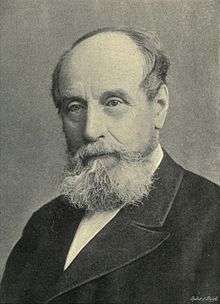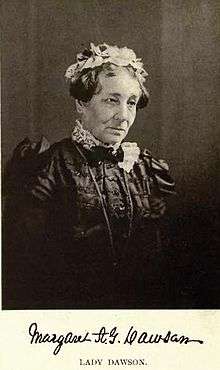John William Dawson
| Sir John William Dawson | |
|---|---|
 Sir John William Dawson | |
| Born |
13 October 1820 Pictou, Nova Scotia |
| Died |
19 November 1899 (aged 79) Montreal, Quebec |
| Nationality | Canadian |
| Fields | geology |
| Institutions | McGill University |
| Alma mater | University of Edinburgh |
| Known for | Eozoon canadense; Hylonomus |
| Influences | Robert Jameson |
| Notable awards | Lyell Medal (1881) |
| Author abbrev. (botany) | Dawson |
Sir John William Dawson, CMG, FRS, FRSC, FRSE, FGS (13 October 1820 – 19 November 1899), was a Canadian geologist and university administrator.[1]
Life and work
John William Dawson was born in Pictou, Nova Scotia, where he attended and graduated from Pictou Academy. Of Scottish descent, Dawson attended the University of Edinburgh to complete his education, and graduated in 1842, having gained a knowledge of geology and natural history from Robert Jameson.
Dawson returned to Nova Scotia in 1842, accompanying Sir Charles Lyell on his first visit to that territory. Dawson was subsequently appointed as Nova Scotia's first superintendent of education. Holding the post from 1850 to 1853, he was an energetic reformer of school design, teacher education and curriculum. Influenced by the American educator Henry Barnard, Dawson published a pamphlet entitled, "School Architecture; abridged from Barnard's School Architecture" in 1850. One of the many schools built to his design, the Mount Hanley Schoolhouse still survives today, including the "Dawson Desks" named after him. Dawson's travels as school superintendent allowed him to deepen his geological studies, as he visited and studied geological sites across the region, leading to publication of his classic "Acadian Geology" (1855 and subsequent editions). He entered zealously into the geology of Canada, making a special study of the fossil forests of the coal-measures of Joggins, Nova Scotia, now a UNESCO World Heritage Site. During the course of his second exploration of the cliffs with Charles Lyell in 1852, he discovered the remains of a tetrapod named Dendrerpeton entombed within a fossil tree. Over the years, he continued his exploration of the fossil trees, eventually unearthing the oldest known reptile in the history of life, which he named Hylonomus lyelli in honour of his mentor.[2]
From 1855 to 1893 he was professor of geology and principal of McGill University in Montreal, an institution which under his influence attained a high reputation. In 1859 he published a seminal paper describing the first fossil plant found in rocks of Devonian origin. Although his discovery did not have the impact which might have been expected at the time,[3] he is now considered one of the founders of the science of palaeobotany. He later described the fossil plants of the Silurian, Devonian and Carboniferous rocks of Canada for the Geological Survey of Canada (1871–1873). He was elected FRS (Fellow of the Royal Society) in 1862. When the Royal Society of Canada was created he was the first to occupy the presidential chair, and he also acted as president of the British Association at its meeting at Birmingham in 1886, and president of the American Association for the Advancement of Science.
Sir William Dawson's name is especially associated with Eozoon canadense, which in 1865 he described as an organism having the structure of a foraminifer. It was found in the Laurentian rocks, regarded as the oldest known geological system. His views on the subject were contested at the time, and have since been disproven, the so-called organism being now regarded as a mineral structure.
He was appointed CMG in 1881, and was knighted in 1884. In 1882, while looking to fill the vacancy left at McGill by the death of botanist James Barnston, Dawson contacted Asa Gray of Harvard University for recommendations. Gray suggested his former assistant David P. Penhallow, who Dawson accepted as a lecturer.[4]
Besides many memoirs in the Transactions of learned societies, he published several books:
- Acadian Geology – The geological structure, organic remains and mineral resources of Nova Scotia, New Brunswick, and Prince Edward Island (1855; ed. 3, 1878);
- Air-breathers of the Coal Period (1863);
- The Story of the Earth and Man (1873; ed. 6, 1880);
- The Dawn of Life (1875);
- Fossil Men and their Modern Representatives (1880);
- Geological History of Plants (1888);
- The Canadian Ice Age (1894).
- The Meeting-Place of Geology and History (1894).
A Christian, Dawson spoke against Darwin's theory of evolution and came to write The Origin of the World, According to Revelation and Science (1877) and Facts and Fancies in Modern Science: Studies of the Relations of Science to Prevalent Speculations and Religious Belief (1882) where he discussed how science and religion (particularly Christian Revelation) were complementary in his view.[5] In his books on geological subjects he maintained a distinctly theological attitude, refusing the theory of human evolution from brute ancestors, and holding that the human species only made its appearance on this earth within quite recent times. Like Arnold Henry Guyot, Hugh Miller, and James Dwight Dana, he defended day-age creationism.[6]
He died in Montreal, 19 November 1899, and was buried in Mount Royal Cemetery. Lady Dawson served as President of the Ladies' Bible Association. Lady Dawson cofounded the Ladies' Educational Institute of Montreal with Mrs. John Molson and others. Lord and Lady Dawson had several sons. The eldest, Dr. George Mercer Dawson, F.R.S., C.M.G., served as Director of the Geological Survey of Canada, in 1895.
He is interred in the Mount Royal Cemetery in Montreal, Quebec and is the namesake for Dawson College. The mineral dawsonite, which was discovered during the building of the Redpath Museum with which he was intimately related, is named in his honour.[7]
Family

John William Dawson married Margaret A. Y. Mercer, daughter of G. Mercer, of Edinburgh, Scotland in March 1847. The couple lived at 293 University Street, Montreal. One of John's sons, George Mercer Dawson (1849–1901), became a well known and respected scientist and geologist in his own right.
Bibliography
- Dawson, William (1901). Fifty Years of Work in Canada. London: Ballantyne, Hanson & Co.- Edited by Rankine Dawson
- Dawson, William (1890). Modern Ideas of Evolution as Related to Revelation and Science. Religious Tract Society (reissued by Cambridge University Press, 2009; ISBN 978-1-108-00023-9)
References
- ↑ "DAWSON, Sir JOHN WILLIAM". biographi.ca. Retrieved 24 September 2013.
- ↑ Calder, John (2012), "The Joggins Fossil Cliffs, Coal Age Galápagos", Province of Nova Scotia, 96 pp. ISBN 978-1-55457-473-5
- ↑ Taylor, T.N.; Taylor, E.L. & Krings, M. (2009). Paleobotany, The Biology and Evolution of Fossil Plants (2nd ed.). Amsterdam; Boston: Academic Press. ISBN 978-0-12-373972-8., p. 225ff
- ↑ Dictionary of Canadian biography, David Penhallow entry
- ↑ Sheets-Pyenson, Susan (1996), John William Dawson: Faith, Hope and Science, McGill-Queen's Press MQUP. pp. 123–126
- ↑ Randy Moore, Mark Decker, Sehoya Cotner (2010). Chronology of the Evolution-creationism Controversy. ABC-CLIO. p. 69
- ↑ Harrington, B.J. (1874). "Notes on dawsonite, a new carbonate.". The Canadian Naturalist and Quarterly Journal of Science. 7: 305–309.
- ↑ IPNI. Dawson.
-
 This article incorporates text from a publication now in the public domain: Chisholm, Hugh, ed. (1911). "Dawson, Sir John William". Encyclopædia Britannica. 7 (11th ed.). Cambridge University Press. p. 874.
This article incorporates text from a publication now in the public domain: Chisholm, Hugh, ed. (1911). "Dawson, Sir John William". Encyclopædia Britannica. 7 (11th ed.). Cambridge University Press. p. 874.
Further reading
Clark, T.H. (1970–80). "Dawson, John William". Dictionary of Scientific Biography. 3. New York: Charles Scribner's Sons. pp. 607–609. ISBN 978-0-684-10114-9.
External links
| Wikimedia Commons has media related to John William Dawson. |
| Wikisource has original text related to this article: |
- Biography at the Dictionary of Canadian Biography Online
- Biography from the Museum of Nova Scotia
- Genealogical detail, traced by his great-grandson
- Sir John William Dawson in 1874
- Sir John William Dawson in 1884
- Sir John William Dawson in 1895
- Works by John William Dawson at Project Gutenberg
- Works by or about John William Dawson at Internet Archive
| Professional and academic associations | ||
|---|---|---|
| New institution | President of the Royal Society of Canada 1882–1883 |
Succeeded by Pierre-Joseph-Olivier Chauveau |